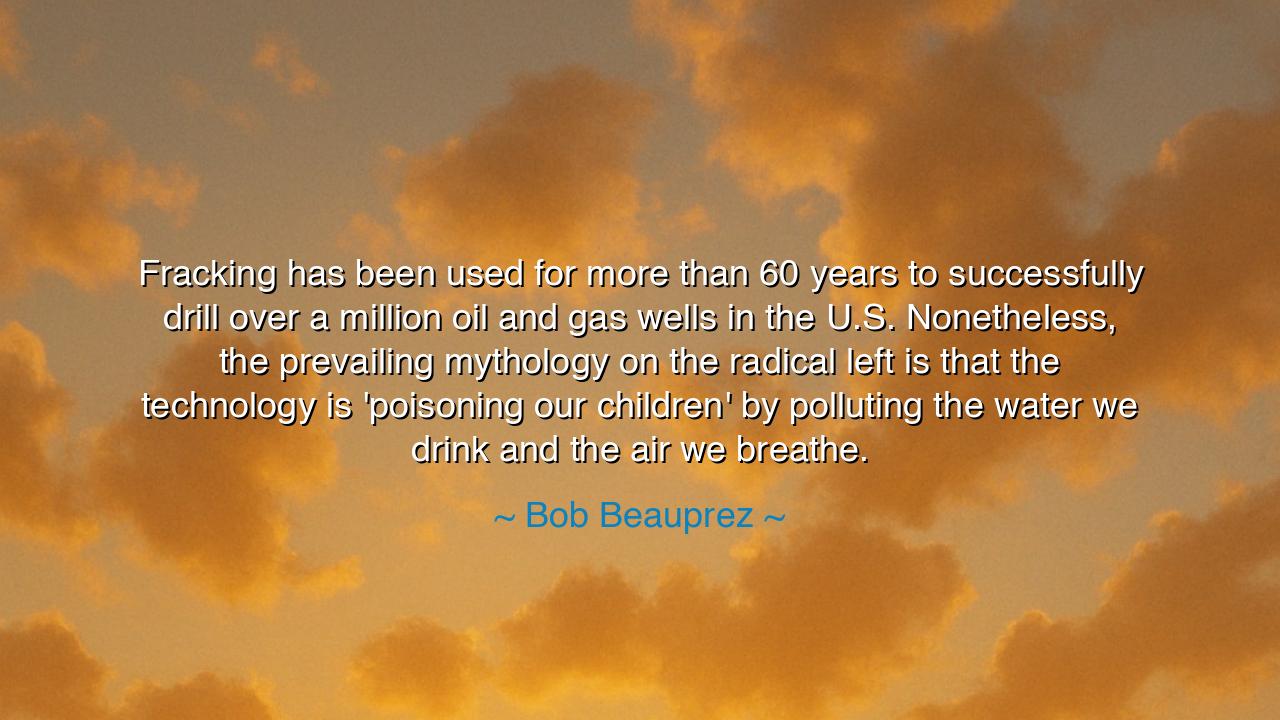
Fracking has been used for more than 60 years to successfully
Fracking has been used for more than 60 years to successfully drill over a million oil and gas wells in the U.S. Nonetheless, the prevailing mythology on the radical left is that the technology is 'poisoning our children' by polluting the water we drink and the air we breathe.






In the cadence of a town crier’s bell, Bob Beauprez declares: “Fracking has been used for more than 60 years to successfully drill over a million oil and gas wells in the U.S. Nonetheless, the prevailing mythology on the radical left is that the technology is ‘poisoning our children’ by polluting the water we drink and the air we breathe.” Hear how the sentence is forged: first, a claim of longevity and scale; second, a charge of mythology; third, a clash between fear and familiarity. The oracle asks us to hold two truths at once—that a tool can be both common and contested, that a practice may feed the hearth and still trouble the heart. It summons a harder virtue than outrage: discernment.
To weigh such a saying, we turn to the record, for the elders taught that wisdom begins in witness. The historical ledger shows hydraulic fracturing used in the United States since the late 1940s, with commercial deployments by mid-century and widespread adoption in later decades; by the 2010s, hundreds of thousands of wells were being drilled with the method, and estimates of hydraulically fractured wells run into the seven figures depending on definitions and databases. These are not whispers but entries in public chronicles.
Yet the same chronicles record anxieties that are neither idle nor new: investigations and peer reviews tracking the water cycle of fracturing—from sourcing and mixing to injection, flowback, spills, and disposal—have identified pathways of risk to drinking water and air, varying by geology, engineering, and governance. The U.S. environmental authority’s 2016 national assessment, cautious but clear, describes conditions under which impacts have occurred, and factors—like well integrity, wastewater handling, and local hydrogeology—that shape frequency and severity. Thus the picture is not a fable of innocence or of doom, but a map of conditions.
Let a lamp be lifted from a place that learned these lessons in pain: Dimock, Pennsylvania. There, amid hills stitched with pastures, families lit their taps and watched flame bloom. Years of dispute yielded charges and, later, a plea agreement and funding for a public water system; regulators have since set terms for limited resumption beyond a protected zone. The story is not emblematic of all wells, but neither is it a rumor; it is a testimony that mistakes and poor practice can write themselves into kitchen sinks and children’s lungs.
So what is the meaning of Beauprez’s oracle? It reminds us that scale and seniority do not, by themselves, convict a technology of harm—nor do they absolve it. The phrase “prevailing mythology” points to the human habit of trading complexity for certainty. But the antidote to myth is not counter-myth; it is measure: baselines before drilling, monitoring during, remedies after; transparent data; enforceable standards; and the humility to pause where geology or governance cannot carry the load.
The origin of the saying lies in our modern quarrel between energy and environment—a quarrel sharpened by economic need, regional identity, and the clock of climate. The industry points to decades of practice and to improved casing, cementing, and emissions controls; communities point to spills, stray gas, flares, truck convoys, and the slow arithmetic of cumulative risk. Between them stands the public square, which must prefer evidence to epithets, and policies that reward good actors and retire bad ones.
What, then, is the lesson to carry like a seal on the heart? First, reject the easy extremes: neither canonize nor demonize fracking; insist on standards that match the stakes—well-integrity testing, closed-loop wastewater systems, tight methane controls, and setbacks that honor human lungs. Second, demand baseline water and air testing with public registries, so truth has a place to stand. Third, link permits to performance: violations should cost dearly; excellence should be rewarded. Fourth, diversify the local energy economy—efficiency, wind, solar, storage—so no town’s fate hinges on a single boom.
Finally, keep the tone of the ancients: courageous, not credulous; prudent, not paralyzed. Let parents, engineers, regulators, and workers share one vow: that no barrel or cubic foot is worth a child’s breath. Let companies bend their craft to the world’s grammar, and let citizens keep watch without rancor. For only when knowledge governs power can a people harvest heat from the deep places of the earth without setting their own house alight. And only when we choose the long view—beyond slogans and seasons—will the wells we drill also be the wells of trust from which our children may safely drink.






AAdministratorAdministrator
Welcome, honored guests. Please leave a comment, we will respond soon